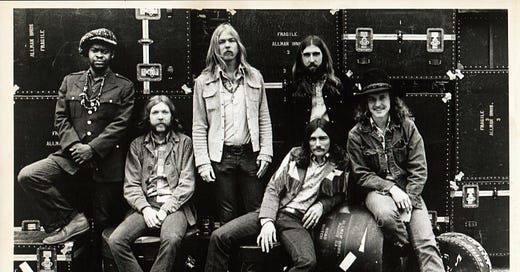Duane Allman: The Allman Brothers at the Fillmore East
A Behind-The-Scenes Account of a Classic Recording

Even in its earliest incarnation, the Georgia-based Allman Brothers Band was distinctive. For starters, its integrated lineup featured two lead guitarists (Duane Allman and Dickey Betts) and two drummers (Jaimoe and Butch Trucks). Singer/keyboardist Gregg Allman and bassist Berry Oakley rounded out the lineup. As it developed, the group pioneered the progressive, guitar-intensive, jam-oriented approach that became known as the “Southern sound.”
Asked if it’s accurate to proclaim Duane the “father” of this musical movement, Gregg told me, “That would be real accurate. He had to do with a lot of the spontaneity of the whole thing. He was like the mother ship, right? He had this real magic about him that would lock us all in, and we’d all take off. Yeah, he really had that quality.” The best source to hear happening in real time is the Allman’s 1971 double-album, At Fillmore East. More than a half-century after its recording, this extraordinary set of original songs and blues covers holds its place among the finest live albums ever made.
By the time of their arrival at the famed New York venue, the Allman Brothers had released two studio albums, The Allman Brothers Band and Idlewild South. The group’s truest turf, though, was the stage. Their long, hard-jamming concerts had many fans proclaiming them “The best damn band in the land.” Duane and Dickie could solo extensively without losing heat, building to climax after climax. Duane called it “natural fire,” explaining, “We have rough arrangements, layouts of the songs, and then the solos are entirely up to each member of the band. The naturalness of a spur-of-the-moment type of thing is what I consider the most valuable asset of our band.” Nowhere is this more evident than on At Fillmore East.
A 2,600-seat theater at 105 Second Avenue in New York City’s Lower East Side, the Fillmore East had been opened by concert promoter Bill Graham in March 1968. Graham typically booked three bands per nights, with each triple-bill performing two sets per night. The venue had superior sound, and Jimi Hendrix, Joe Cocker, Miles Davis, Derek and the Dominos, the Grateful Dead, The Who, Traffic, Frank Zappa, Mountain, and Johnny Winter were among the dozens of acts who recorded there. As Allman drummer Jaimoe described in Scott Freeman’s Midnight Rider, “That stage was smoking, believe me. You could walk on that stage, man, and you could hit your instrument and the presence of it was there. It had echo off the back of the room. The acoustics were just great.”
Tom Dowd, who’d produced Layla and 1970’s Idlewild South, was brought in to produce the live album. Long a mainstay at Atlantic Records, Dowd had worked with everyone from jazz icons John Coltrane and Charlie Parker to a veritable who’s-who of rock and pop. Duane, Gregg, and the rest of the band respected his decisions. Aaron Baron and Larry Dahlstrom were enlisted to handle the engineering.
In all, Graham booked the Allman Brothers to perform three nights in a row beginning on Thursday, March 11, 1971. Joining them on the triple bill were the Elvin Bishop Group and Johnny Winter. On the first night, the Allmans were slotted between Elvin Bishop and headliner Johnny Winter. Apparently, the Allmans played so ferociously that both Johnny Winter and his manager insisted that they switch places on Friday and Saturday nights. It was a fortuitous decision: As headliners, the Allmans could play much longer sets than the 90 minutes allotted to middle acts.
Keep reading with a 7-day free trial
Subscribe to Talking Guitar ★ Jas Obrecht's Music Magazine to keep reading this post and get 7 days of free access to the full post archives.


